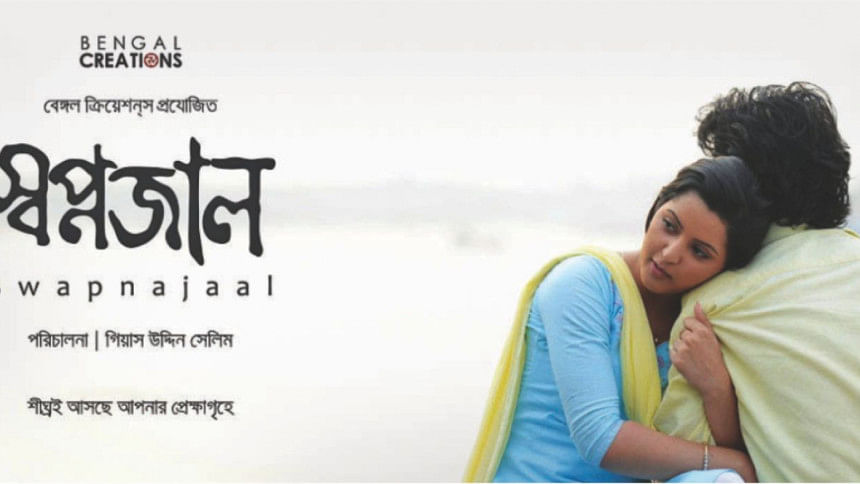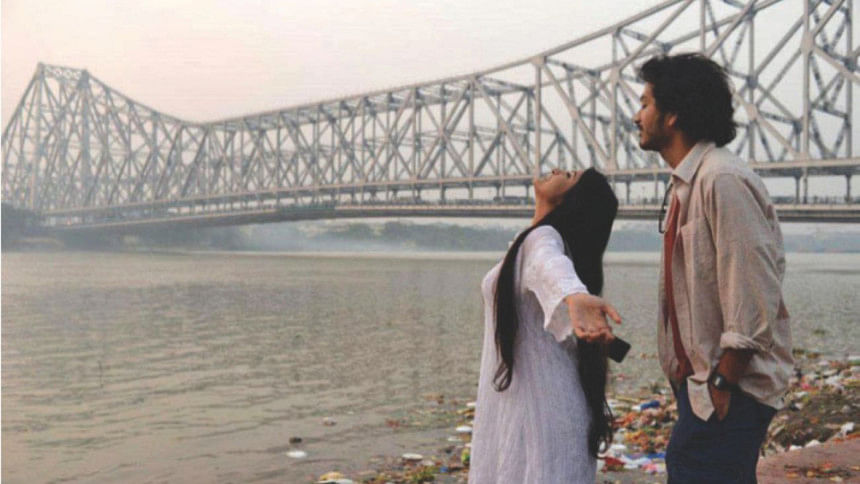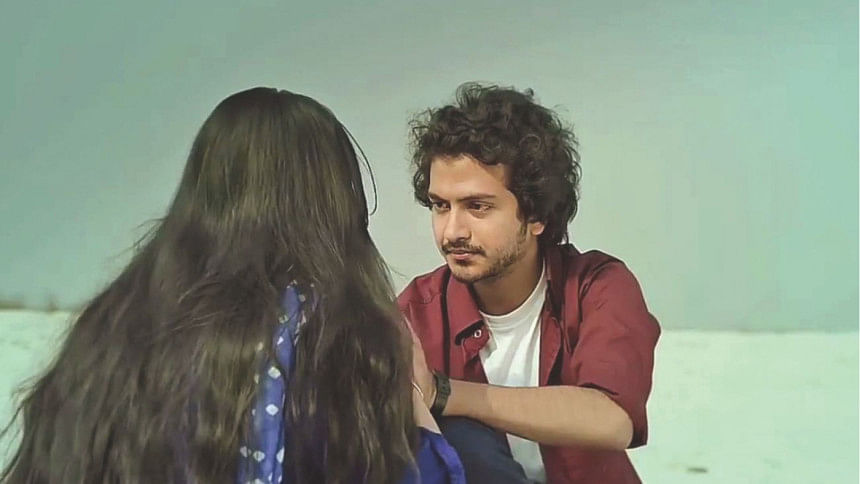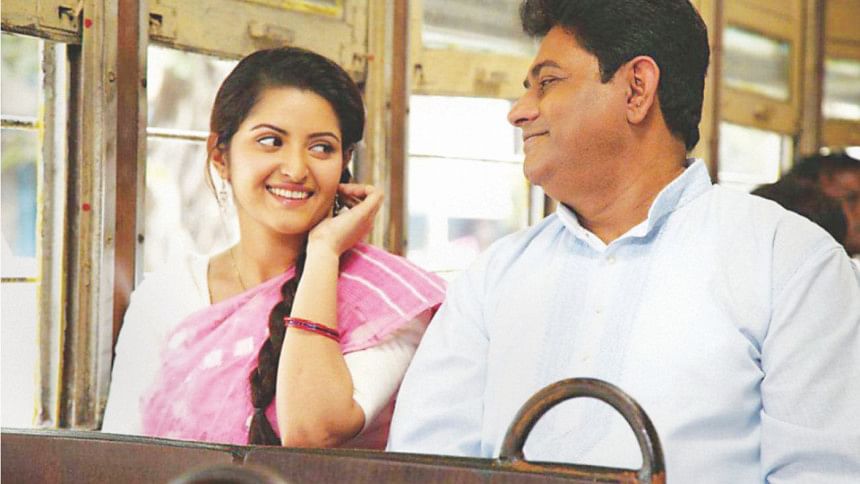Love and Loss in Giasuddin Selim's “Swapnajaal”

Disclaimer: This essay contains spoilers from the film
Giasuddin Selim's comeback movie stars Porimoni and newcomer Yash Rohan as love-struck teenagers Shuvra and Apu respectively. The story is set in Chandpur in the 90s and follows the lovers' relationship through various trials. But within its layers, larger themes lay afloat, waiting to be addressed but never completely getting its due.
The story is a familiar one, a local version of Shakespeare's Romeo and Juliet almost, whether intended or unintended. It begins with showing us the already existing young love between Apu and Shuvra. In the first half, Shuvra's father is threatened and kidnapped and then killed by the local tyrant Aynal Gazi. Shuvra's family receive a fake letter from the father saying that he married a young girl and relocated to Kolkata and advises the family to migrate as well. Shuvra is separated from her lover by course of circumstance. In the second half, Apu helps Shuvra expose her father's killer which leads to Aynal Gazi's arrest. However, at the end of this story sprouts out another story of star-crossed lovers who are forbidden to marry due to their family's differing religions. The extended storyline feels unnecessary and could very well have been a film of its own.
There are some brilliant aspects of the film, namely Kamrul Hasan Khosru's cinematography and Rasheed Sharif Shoaib's music. The two go hand in hand in glamourising the idyllic landscape of suburban Chandpur. Slow motion love songs are a classic visual favourite of the South Asian audience and Swapnajaal does a good job of delivering that essence without feeling recycled. It is obvious that the panoramic scenes and melodies witnessed in songs such as “Emon kore bolchi” will remain in the hearts of Bengali film goers for years to come.

However, in terms of script, the film falls short with various plot-holes and premature character development. The two main characters are barely provided any constructive dialogue. Perhaps the scriptwriter intended to depict a certain naivety prevalent in young people through these unsophisticated dialogues. But what is rather apparent in this is the writer's shallow understanding of youth mentality. Young people should be given more credibility for their thoughts and ideas—especially ones madly in love. Shuvra and Apu barely know how to express emotion beyond “Tumi kintu amar” or “Tomake chara amar valo lagche na”. Yet, these are the same kids travelling to another country for the sake of love. In order to make such actions believable, the characters must at least speak with some depth and determination. First love, and that too at such a young age, makes for a powerful exhibition of passion which is left untapped in the film's dialogues. Moreover, neither the dialogues nor the letters exchanged by the lovers help advance the plot.
The relationship itself remains surprisingly consistent throughout the film, never evolving through the stressful events. There could have been moments of conflict, for example, when Shuvra comes home drunk one night with her older neighbour who was trying to take advantage of her. Neither Apu nor Shuvra seem disturbed by the neighbour's perversion and the issue is reconciled all too easily. This is only one example of the numerous sub-plots that either lay hanging without any resolution or are resolved much too easily without impacting the larger narrative.

It would be unfair, then, to comment on Porimoni or Yash Rohan's acting considering the simple material they were given to work with. Porimoni's role is, of course, a refreshing venture away from her usual glitzy portrayals but whether she fared well in it is hard to tell when the character itself is so one-dimensional. The only character riding in favour for the movie is Aynal Gazi, brought to life by the exceptional acting of Fazlur Rahman Babu. The veteran actor fleshes out Gazi as sickening in character as in health. His depiction of the villain is genuinely grotesque. It is indeed Gazi's character and story-arch that brings forth some sort of nuance to the film.
What troubled me most in the film was its closure. The story ends with Shuvra getting married to someone else for which Apu jumps from the steamer launch and commits suicide. Here, we must remember that Apu is barely 18 years of age, having just completed his HSC and on his way to Dhaka to start coaching for university admission. He is at a vulnerable stage in life, having lost the love of his life to someone else. At this very helpless situation, the writer-director decides that the only way to redeem this kid is by having him plunge to his death. Was there absolutely no other way for Apu to deal with his first heartbreak?
It is rather common for teenagers to fall in love, much more passionately perhaps than adults. Often times young lovers don't get their happy ending due to parental restrictions. But it is unfair to assume that the only way to reconcile with such situations is by taking your own life. When I watched the movie, the theatre was packed with families with young children ranging from 6-13 years of age. What bothers me is that these kids will go home thinking Apu is a hero in this story when the truth is, nobody wins when it comes to suicide.

Romeo and Juliet too ended in suicide, but the significance of the suicide was how futile it was—the two lovers committed them in vain and as a mistake. Where Shakespeare's writing of suicide is a warning of such fate, Giasuddin Selim's writing of suicide is a glorification of it. Apu's demise is portrayed as martyrdom instead of tragedy. I am not saying that Apu and Shuvra's love cannot remain immortal just because they were young or that we should expect them to move on. My issue is only with how the film chooses suicide as its optimal closure. Apu and Shuvra could have passed their lives in thoughts of the other, still loving each other as bright as their first day in love, without anyone dead.
In short, Swapnajaal seems to be two films in one. While it covers some important themes, namely violence, suicide, and communal differences, it does so with a surface-level approach. It hosts multitude potential in various points of the story which miss their target destinations within the narrative. The film will undoubtedly bring audiences back to the theatre but whether it will provide anything thoughtful to those watching is questionable.
Sarah Nafisa Shahid studied Art-History at McGill University, Canada and is a columnist of Star Weekend.










Comments